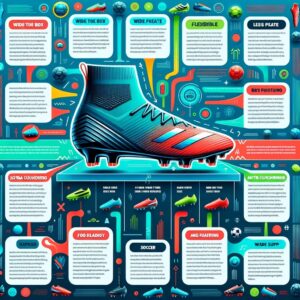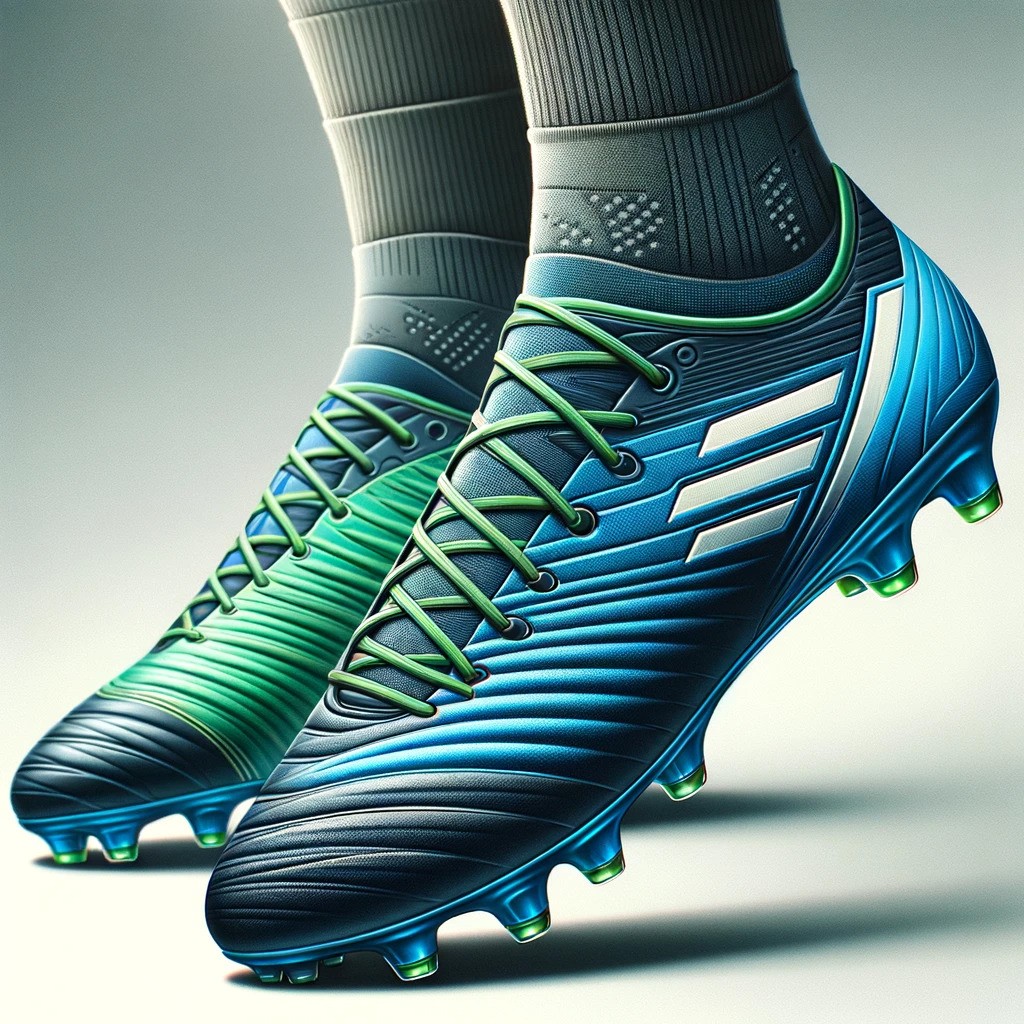Soccer is a sport that captivates hearts worldwide, and it demands not only exceptional skill but also the right equipment. Central to a soccer player’s gear are their cleats, playing a pivotal role in performance. Especially for those with wider feet, selecting the right cleat is crucial. This article delves into soccer cleats with a wide toe box, designed for comfort and injury prevention, ensuring players can fully concentrate on their game without the hindrance of foot discomfort.
The right pair of soccer cleats is more than just footwear; it’s a critical tool that enhances agility, speed, and control on the field. For players with wider feet, standard cleats can often lead to discomfort, blisters, or even long-term foot problems. This is where soccer cleats with a wide toe box become significant. They are specifically designed to accommodate wider feet, providing ample space in the toe area.
This ensures a comfortable fit, allowing players to perform at their best without the distraction of cramped or uncomfortable feet.
What is a Wide Toe Box in Soccer Cleats?
A wide toe box in soccer cleats refers to the front part of the shoe that provides additional space for the toes. This feature is crucial for players with wider feet. Standard soccer cleats, often designed with a narrower front, can cause discomfort, restrict movement, and even lead to injuries for these players. In contrast, a wide toe box allows for a more natural toe spread, which is vital for maintaining balance and stability during quick movements and direction changes typical in soccer.
The importance of a wide toe box goes beyond comfort. It’s about the health of the player’s feet. A cramped toe area can lead to issues like bunions, corns, and hammer toes. These conditions not only cause pain and discomfort but can also affect a player’s ability to run, cut, and strike the ball effectively.
The wide toe box design mitigates these risks by providing a fit that accommodates the natural shape and movement of the feet, thereby enhancing overall foot health and performance on the field.
Why Choose Soccer Cleats with a Wide Toe Box?
Choosing soccer cleats with a wide toe box is a decision that significantly benefits players, especially those with wider feet. This section will explore the various advantages of opting for such cleats, underlined by appropriate subheadings.
Enhanced Comfort
The primary advantage of soccer cleats with a wide toe box is the enhanced comfort they provide. Standard cleats often squeeze and compress the toes, leading to discomfort and even pain during play. A wide toe box allows the toes to spread naturally, conforming to the foot’s natural shape and movement. This design reduces the pressure on the toes, thereby preventing issues such as blisters, corns, and general discomfort.
Improved Performance
Beyond comfort, wide toe box cleats contribute to improved on-field performance. With extra space in the toe area, players can achieve better balance and stability, crucial for soccer’s quick movements and sharp turns. A comfortable fit also means players can focus on their game without being distracted by foot discomfort, leading to improved agility and responsiveness during play.
Injury Prevention
Another significant reason to choose wide toe box cleats is injury prevention. Tight, ill-fitting cleats can lead to various foot problems, including bunions, hammertoes, and ingrown toenails. These issues not only cause discomfort but can also lead to more severe foot ailments over time. Wide toe box cleats reduce the risk of these injuries by providing ample room for the toes, thus promoting better foot health.
Customizable Fit
Wide toe box cleats often come with customizable features, such as adjustable straps or laces, allowing for a more tailored fit. This adaptability is crucial for players with unique foot shapes or specific fitting needs, ensuring that each player can find a cleat that fits perfectly.
Long-Term Comfort and Durability
Finally, soccer cleats with a wide toe box are designed for long-term comfort and durability. These cleats are made with quality materials that withstand rigorous play while maintaining their shape and providing consistent support. This longevity means players can enjoy sustained comfort and performance over multiple seasons.
Key Features to Look for in Soccer Cleats with Wide Toe Box

Selecting the right soccer cleats with a wide toe box involves considering several key features to ensure maximum comfort, performance, and durability. This section explores these features in detail, categorized under different subheadings.
- Appropriate Material for Flexibility and Comfort
The material of the cleat plays a vital role in its overall performance and comfort. For wide toe box cleats, materials like soft kangaroo leather or high-grade synthetic fabrics are ideal. Kangaroo leather is prized for its ability to mold to the foot’s shape, offering a snug yet comfortable fit. High-quality synthetic materials, on the other hand, provide durability and maintain shape over time, while also offering flexibility.
- Spacious Toe Box for Enhanced Fit
The toe box should be sufficiently wide to allow room for the toes to spread naturally. This space is crucial for comfort, especially for players with wide feet. A cramped toe box can lead to discomfort and foot ailments, so the width of the toe box is a primary consideration.
- Supportive Insole and Midsole for Arch Support
Good arch support is crucial in soccer cleats, as it helps in distributing pressure evenly across the foot, reducing fatigue and the risk of foot injuries. Look for cleats with a supportive insole and a cushioned midsole, which provide both comfort and shock absorption during play.
- Breathability for Foot Health
Cleats that offer good breathability help in keeping the feet cool and dry, reducing the risk of blisters and athlete’s foot. Features such as perforated uppers or moisture-wicking interior linings are beneficial in promoting air circulation inside the shoe.
- Lightweight Design for Enhanced Performance
A lightweight design can significantly improve a player’s speed and agility on the field. However, it’s important to ensure that reducing weight does not compromise the cleat’s structural support and durability.
- Durable Outsole for Traction and Stability
The outsole of the cleat should be durable and provide ample traction. This is crucial for stability during quick turns and sprints. Look for cleats with well-designed stud patterns that offer grip on different playing surfaces.
- Customizable Lacing System for a Secure Fit
A customizable lacing system allows players to adjust the fit according to their foot shape and preference. This feature is particularly beneficial for players with wide feet, as it enables them to secure the cleat comfortably without creating pressure points.
- Heel Support and Padding for Impact Protection
Adequate heel support and padding are essential to protect the foot from impacts. This feature helps in reducing the risk of heel pain and injuries, which are common in sports with frequent starts and stops like soccer.
How to Determine If You Need Wide Toe Box Cleats
Determining if you need wide toe box cleats is crucial for comfort and performance. The first step is to measure your foot width. This can be done by tracing your foot on a piece of paper and measuring the widest part. Compare this measurement with standard sizing charts available from cleat manufacturers.
Physical signs also indicate the need for wide cleats. If you experience pinching at the sides of your feet, blisters, or pressure points after playing, your current cleats might be too narrow. Persistent discomfort, especially around the toes, is a clear sign that more room is required.
Pay attention to the shape of your feet as well. Players with naturally wide feet, flat feet, or prominent bunions would benefit significantly from a wide toe box design. Remember, the right fit is not just about length; the width is equally important for overall foot health and comfort.
The Importance of Proper Fit
The importance of a proper fit in soccer cleats cannot be overstated. A well-fitting cleat is essential for long-term foot health. Ill-fitting cleats can lead to a range of foot problems, including blisters, bunions, corns, and in severe cases, structural foot issues. These problems can affect not only your comfort on the field but also your overall foot health in the long term.
A proper fit also significantly impacts your playing style. Cleats that fit well provide better support, allowing for more precise turns, sprints, and stops. This can enhance your agility, speed, and overall performance. On the contrary, cleats that are too tight or too loose can hinder your movement, causing instability and increasing the risk of ankle and foot injuries.
When trying on soccer cleats, always wear the same type of socks you would wear during a game. This ensures the fit you feel is the fit you’ll experience on the field. It’s also advisable to try on cleats later in the day when your feet are likely to be at their largest due to natural swelling.
Always stand and walk around in the cleats to ensure there’s enough room for your toes and that there’s no unwanted pressure or discomfort. Remember, the right fit can make a significant difference in your comfort, performance, and enjoyment of the game.
Soccer Cleats for Children with Wide Feet
When it comes to children’s soccer cleats, finding the right fit is crucial for their growing feet. Children with wide feet often face discomfort and restrictions in standard cleats. It is essential to choose cleats with a wide toe box to provide comfort and prevent foot problems that can arise from poorly fitting shoes.
The key to selecting soccer cleats for children with wide feet is to look for adjustable features, such as laces or Velcro straps, which can provide a more customizable fit. Brands like Adidas, Nike, and New Balance offer junior models specifically designed for wider feet. These cleats not only offer more room in the toe area but also come with supportive insoles and flexible materials that adapt to the shape of a child’s foot.
Another important aspect is to ensure that the cleats are made of durable, yet comfortable materials. Children’s feet grow quickly, and their cleats should be able to withstand regular use and changing foot sizes. Moreover, considering the active nature of children, cleats with good traction and stability are essential to prevent slips and falls on the field.
Parents should also pay attention to the size and fit of the cleats. Unlike adult sizes, children’s cleats should have a bit more room to accommodate growing feet, but not too much as to cause instability. Regularly checking the fit of the cleats and updating them as the child’s foot grows is important to maintain comfort and performance.
Conclusion
Choosing the right soccer cleats, especially for those with wide feet, is a decision that can significantly impact comfort, performance, and foot health. From the importance of a wide toe box in providing ample space for the toes, to the key features such as material quality and design elements that enhance fit and comfort, it’s clear that the right cleats can make a world of difference on the field.

